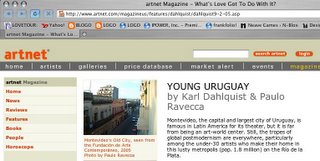|
Young Uruguay
ARTNET
enlace: artnet.com
NYC. USA
Por Karl Dahlquist y Paulo Ravecca
The "Logo" group in "13 por 13" at CCE
Not far from FAC is the impressive Centro Cultural de España (CCE), where the exhibition "13 por 13: Trece Curadores/Trece Artistas" ("Thirteen Curators/Thirteen Artists") can be found, July 12-Sept. 19, 2005. Organized by Patricia Bentancur, CCE’s visual arts director, the exhibition focuses as much on the challenges of "curating the contemporary" as it does on the artworks themselves, inviting 13 different curators to choose an artist that they consider "contemporary."
At the vernissage, we found the artists Mariana Ures (b. 1977) and Felipe Ridao (b. 1978), who work together as a collaborative called LOGO. Their work for "13 por 13" is a critical survey asking visitors to rank the "contemporariness" of each work and the show itself -- and also of Uruguay’s new center-left government. In general, the artists are concerned with the language of cultural control in the city and the financial capital that underlies it. For Ures and Ridao, the most important question in their survey regards the absence of compensation for artists who exhibit in the cultural centers of Uruguay. The sobriety of the questionnaire offers a chilly contrast to the illusion of prosperity created by the wine and smiles of the elegant visitors at gallery openings.
Another Logo venture is the "LOVETOUR:" (see www.logo.net.uy/lovetour), a Situationist-inspired endeavor for which they perform different urban interventions. Recently, they embarked on a project to explore the type of perception specific to tourism, conceiving of several itineraries through the city for participants, recording their observations in a pseudo-scientific manner. The Lovetour is documented in Logo’s own artist-designed magazine, on their web page and in installations, including one at the "Salón Anual Municipal de Artes Visuales 2004," which also doubled as a recruitment effort for the tours.
Logo cites Antoni Muntadas, Laura Baigorri and Hiroshi Hara as influences. "The material aspects of our work are passageways to the abstract," Ridao says. "It is the conceptual part that matters." LOGO seems propelled by a vigorous idealism, refreshing in today’s dominant culture of self-indulgent cynicism.
© artnet® 2005
LOGO 13:00